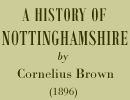< Previous | Contents | Next >

George Gordon Noel, Lord Byron (1788-1824)
For a century or more after these exploits we read little of the Byrons. They took no part in national movements, nor came to the forefront by any display’ of genius or valour. It was not until 1750 ‘that any member of the family attracted public attention, and this was Mr. Byron, afterwards Admiral Byron, a gallant sailor, who published an account of his shipwreck and sufferings’ on a desolate island in the South Seas, which won for him considerable sympathy. A few years later another of the Byrons earned an equally extensive, but less enviable, notoriety. Lord Byron had a quarrel and a duel with his neighbour, Mr. Chaworth, of Annesley, and in the scuffle Mr. Chaworth was slain. The two gentlemen were in the habit of meeting at the Star and Garter tavern, in Pall Mall, at what was called the Nottinghamshire Club. On January 26, 1765, a discussion took place at the club as to the best method of preserving game. Mr. Chaworth, in the course of the debate, said that Sir Charles Sedley had more game on five acres than Lord Byron had on all ‘his manors, and to this statement his lordship demurred. From this trivial incident a fatal duel arose, Mr. Chaworth’s account of it being as follows: That Lord Byron and he entered the room together, Lord Byron leading the way; that his lordship’ in walking forward, said something relative to the dispute, on which he purposed fastening the door; that on turning himself round from this act he perceived his lordship with his sword either drawn or nearly so, on which he instantly drew his own and made a thrust at him, which he thought had either wounded or killed him; that then perceiving his lordship shorten his sword to return the thrust, he thought to have parried it with his left hand; that he felt the sword enter his body and go deep through the back; that he struggled, and being the stronger man, disarmed his lordship, and expressed a concern as under an apprehension of having mortally wounded him; that Lord Byron replied, saying something to a like effect, adding that he hoped now he would allow him to be as brave a man as any in the kingdom. Mr. Chaworth added that he fully forgave Lord Byron, and hoped the world ‘would do so. His lordship was tried before the House of Peers, and dismissed on paying his fees; but ‘little more was heard of him during his lifetime.

The house from the lake (A. Nicholson, 1997).
It was reserved for the poet to win for Newstead and his family a world-wide fame. His grand-uncle, from whom he inherited the title and estate after the fatal quarrel with Mr. Chaworth, led the’ life of a recluse. The mansion and grounds were left neglected, and their condition had become deplorable. Well might the young owner pen the familiar lines:
‘Through thy battlements, Newstead, the hollow’winds whistle,
Thou, the hall of my fathers, art gone to decay:
In thy once smiling garden the hemlock and thistle
Have choked up the rose which late bloomed in the way.’
It was in the summer of 1798 that Lord Byron, then a boy of ten, had his first glimpse of the ancestral home.
He was accompanied by his mother and nurse, and when they reached the Newstead toll-bar and saw the woods of the abbey stretching out to receive them, their minds were filled with varied and impressive emotions. Mr. Moore tells us that Mrs. Byron, affecting to be ignorant of the place, asked the woman at the toll-bar to whom that seat belonged. She was told that the owner of it, Lord Byron, had been some months dead.
‘And who is the right heir?’ asked the proud and happy mother.
‘They say,’ answered the old woman, ‘that it is a little boy who lives at Aberdeen.’
‘And this is he, bless him!’ exclaimed the nurse, no longer able to contain herself, and turning to kiss with delight the young lad who was seated in her lap.
Connected as Newstead thus was with the recollections of his early days—days that are dear in memory to all of us—it became to him a favoured and a cherished spot. Some of the friends of his youth lived there, and it was at Annesley that he formed that devoted attachment for Miss Chaworth, of which he thought and wrote so much.
Writing in 1809, he said thus earnestly, ‘Newstead and I stand or fall together. I have now lived on the spot, I have fixed my heart upon it, and no pressure, present or future, shall induce me to barter the last vestige of our inheritance.’

The Cloister Garth (A. Nicholson, 1997).
It was about this time that he was dispensing at Newstead his abundant hospitality to a circle of college friends, and making the walls echo with strange revels, of which an account is given in a letter of Mr. C. S. Matthews. On that occasion it was their custom or whim to hand burgundy round after dinner in a skull which had been mounted in silver and converted into a drinking-cup. After Lord Byron’s death, Newstead was bought by Colonel Wildman, a schoolfellow of the poet, who spent considerable sums upon it, and it secured an equally liberal possessor on the demise of the gallant Colonel in Mr. W. F. Webb, J.P., who purchased it in 1860. It is a happy circumstance that a place of such worldwide interest should have passed into the hands of an estimable gentleman like Mr. Webb. Under his direction everything of interest, Byronic or historic, has been carefully preserved, and a generous but judicious liberality exercised in permitting the public to visit the house and inspect its beautiful rooms and gardens, and its priceless treasures. Not only has Mr. Webb been thoughtful in his preservation and collection of relics of the poet, but he has linked the abbey with other great names which the world will not willingly let die. Himself a traveller and a sportsman of no ordinary prowess, he was on intimate terms with Dr. Livingstone, and it was at Newstead, in a room known by Livingstone’s name, that ‘The Zambesi and its Tributaries’ was written. In subsequent years Mr. H. M. Stanley, the discoverer of Livingstone, was entertained at the abbey, and planted a tree, as Livingstone had done before him, in memory of his visit to this hospitable abode. Several relics of Livingstone are preserved in the abbey, including the great explorer’s cap and sword; while the Byronian treasures include the plain circular table on which a portion of ‘Childe Harold’ was written; crockery ware, spill-cups, candlesticks, inkstand, swords, single-sticks, boxing-gloves, face-guards, ‘Boatswain’s’ collar, etc.; carved oak chairs, containing embroidery work by Lord Byron’s sister, Augusta; and the rapier with which Mr. Chaworth was killed. The dog’s monument, with its well-known epitaph, is in the gardens.
Space will not permit us to describe the various rooms of the abbey, with their sumptuous adornments. Of the more historic apartments we may mention the monk’s chamber, the great dining-room, once used as a refectory; the breakfast-room, formerly the Abbot’s parlour; Edward III’s bedroom, Henry VII.’s lodgings, a tapestry- room, once occupied by Charles II., and Lord Byron’s bedroom, kept undisturbed, with its adjoining dressing-room. Here may be seen his lordship’s bedstead, with gilded coronets; portraits of Murray, his valet, and of the noted pugilist, ‘Gentleman Jackson’; while in the oriel window is his writing-table and inkstand. In addition to all these attractions, Newstead possesses natural charms which it would be difficult to find excelled, and some of which are graphically depicted by the poet himself in the thirteenth canto of ‘Don Juan.’ The gardens are magnificent, and the pleasure-grounds are arranged in terraces and straight walks by Le N6tre in the style of Hampton Court and Versailles. The estate is beautifully wooded, and in the vicinity of the abbey are two ornamental sheets of water. Everything is kept in the most perfect order, and looking at Newstead as it is to-day, after all that has been done with a generous and unsparing hand since Lord Byron’s time, one cannot but feel that the hope faintly breathed by ‘the poet for his favourite abode has been fully realized:
‘Haply thy sun, emerging, yet may shine,
Thee to irradiate with meridian ray;
Hours splendid as the past may still be thine,
And bless thy future as thy former day.’
Very thankful must all lovers of the poet be that this famous and now magnificent house is in such excellent and kindly keeping, and we can only hope that Mr. and Mrs. Webb, to whom Newstead owes so much, may long be spared to maintain with becoming splendour the ancient and stately abode on which they have lavished so much care and treasure.
